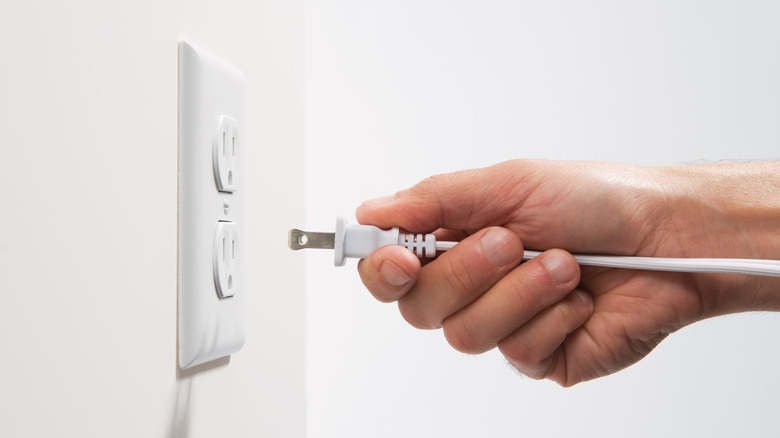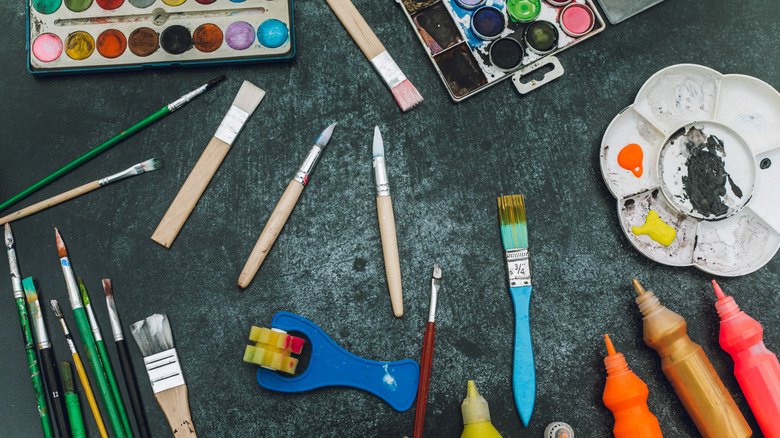Cover Up Your Basic Outlets With A Cute Solution That Adds Whimsy To Your Space
We may receive a commission on purchases made from links.
If you've ever dreamed of living in a fairy garden or enjoy whimsical home decor, putting miniature doors on your walls may be the gateway to bliss. Turning fairy doors into outlet covers can add magic to a child's bedroom or surprise and amuse your guest room's visitors.
YouTuber Rachel Maksy created a video that shows how to make these charming covers. It also highlights the crafty cosplayer's dry wit and Victorian-inspired cottagecore aesthetic. She uses supplies from her home to craft three designs suitable for electrical outlets or light switches. These include a sculpted door that resembles a tree trunk, a door inspired by a stained-glass window, and a Dutch door that lets users access one outlet in a single duplex faceplate while keeping the other covered.
Maksy infuses her creations with "Lord of the Rings" vibes, but don't be afraid to express your own tastes with this project. Pint-size doors can incorporate elements of your favorite design styles, from the sleek lines of midcentury modern architecture to the rustic charm of Joanna Gaines' modern farmhouse look.
Ways to make fairy-door outlet covers
You can fashion fairy doors from a variety of materials, including twigs, aluminum foil, and plastic transparency paper. When choosing your materials, avoid anything that's especially flimsy or flammable. Also select supplies that can accommodate the hardware you'll use to attach your new fairy doors to your outlets' faceplates. Maksy uses small hinges and screws for this purpose, as her video shows. You can help your fairy doors stay shut by affixing tiny magnets to their backs and the fronts of your faceplates.
To achieve the translucent look of stained glass, use transparency paper or another thin, clear plastic you can cut to match the dimensions of an existing faceplate. Start by sketching a fairy door that's the same size as the one you plan to build. If you draft a decoration you'd like to replicate, you can trace it onto your transparency paper. Whether you're tracing or drawing freehand, use a permanent marker with a medium-to-fine tip so your lines don't smear.
To add texture, go over each line with puffy paint, such as this Tulip Puff Paint on Amazon. Once it has dried, paint the spaces between the lines with a mix of acrylic paint and craft glue. Try Elmer's School Glue or Mod Podge, or create your own craft glue with common kitchen ingredients. Whether you paint simple geometric shapes or an intricate botanical design, a bit of light will filter through.
Crafting fairy doors from repurposed materials
Fairy-door outlet covers are a creative way to use leftover wood scraps in your garage. A wood scrap is an especially good base for a sculpted fairy door. First, cut your scrap to match the dimensions of an existing faceplate.
Next, press modeling compound onto the wood and shape it into an architectural feature you'd like your mini-door to showcase. Modeling compounds such as Apoxie Sculpt or Crayola Model Magic can be fashioned into arches, scallops, and more. They can also be stamped or scored with clay sculpting tools. This is an ideal way to add texture to your creation or even inscribe a short message. These two compounds can be painted as well. If you decide to paint a sculpted fairy door, make sure your compound has hardened before proceeding.
No wood scraps at hand? Build a fairy door from popsicle sticks and hot glue. Glue together the long edges of several sticks and then cut leftover sticks into smaller pieces. Use these pieces to add ornamental molding or other 3D details. Afterward, choose a color for your final product. Don't have any paint or wood stain? Create rich-looking color with ingredients from your kitchen. For example, coffee or beet juice can be used to stain wood. An antique-looking dollhouse doorknob makes a nice finishing touch. Or create a knob from something you already have, such as a small button or shiny bead.

